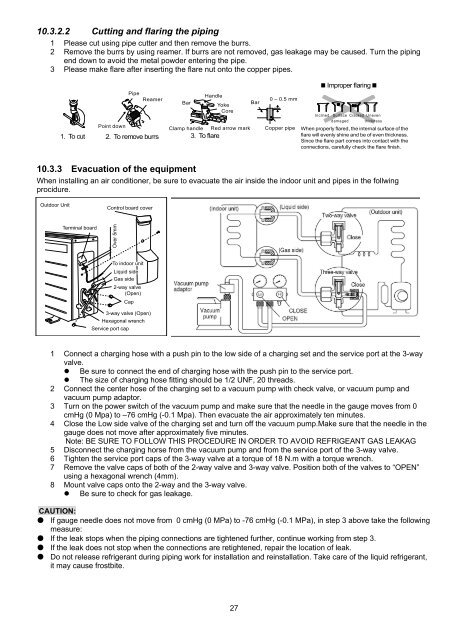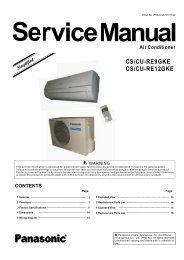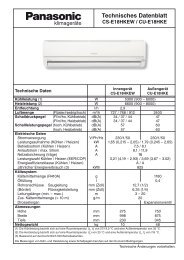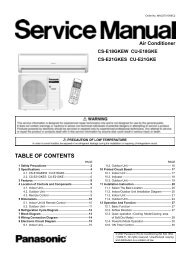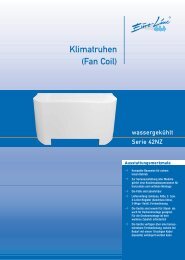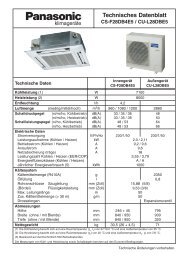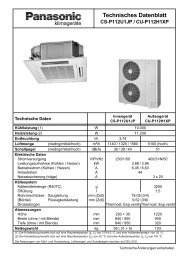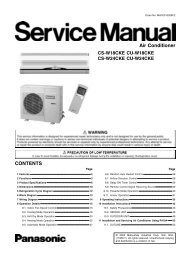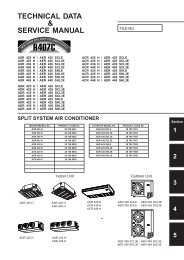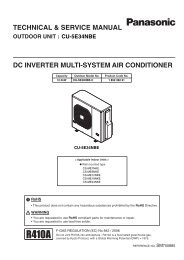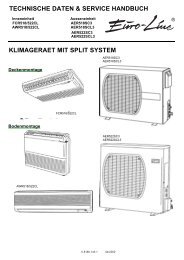Panasonic Air Conditioner
Panasonic Air Conditioner
Panasonic Air Conditioner
You also want an ePaper? Increase the reach of your titles
YUMPU automatically turns print PDFs into web optimized ePapers that Google loves.
10.3.2.2 Cutting and flaring the piping<br />
1 Please cut using pipe cutter and then remove the burrs.<br />
2 Remove the burrs by using reamer. If burrs are not removed, gas leakage may be caused. Turn the piping<br />
end down to avoid the metal powder entering the pipe.<br />
3 Please make flare after inserting the flare nut onto the copper pipes.<br />
1.<br />
To<br />
cut<br />
Point<br />
down<br />
Pipe<br />
Reamer<br />
2.<br />
To<br />
remov<br />
e burrs<br />
Bar<br />
Clamp<br />
handle<br />
Handle<br />
3.<br />
To<br />
flare<br />
Yoke<br />
Core<br />
Red<br />
arrow<br />
mark<br />
27<br />
Bar<br />
0 – 0.<br />
5<br />
Copper<br />
mm<br />
pipe<br />
Improp<br />
er<br />
flaring<br />
In<br />
clin<br />
ed<br />
S urf<br />
ac<br />
e Cra<br />
cke<br />
d U ne<br />
ve<br />
n<br />
da<br />
m ag<br />
ed<br />
th<br />
ick<br />
ne<br />
ss<br />
When<br />
properly<br />
flared,<br />
the<br />
internal<br />
surface<br />
of<br />
the<br />
flare<br />
will<br />
evenly<br />
shine<br />
and<br />
be<br />
of<br />
even<br />
thickness.<br />
Since<br />
the<br />
flare<br />
part<br />
comes<br />
into<br />
contact<br />
with<br />
the<br />
connections,<br />
carefully<br />
check<br />
the<br />
flare<br />
finish.<br />
10.3.3 Evacuation of the equipment<br />
When installing an air conditioner, be sure to evacuate the air inside the indoor unit and pipes in the follwing<br />
procidure.<br />
Outdoor Unit<br />
Terminal board<br />
Control board cover<br />
Over 5mm<br />
To indoor unit<br />
Liquid side<br />
Gas side<br />
2-way valve<br />
(Open)<br />
Cap<br />
3-way valve (Open)<br />
Hexagonal wrench<br />
Service port cap<br />
1 Connect a charging hose with a push pin to the low side of a charging set and the service port at the 3-way<br />
valve.<br />
� Be sure to connect the end of charging hose with the push pin to the service port.<br />
� The size of charging hose fitting should be 1/2 UNF, 20 threads.<br />
2 Connect the center hose of the charging set to a vacuum pump with check valve, or vacuum pump and<br />
vacuum pump adaptor.<br />
3 Turn on the power switch of the vacuum pump and make sure that the needle in the gauge moves from 0<br />
cmHg (0 Mpa) to –76 cmHg (-0.1 Mpa). Then evacuate the air approximately ten minutes.<br />
4 Close the Low side valve of the charging set and turn off the vacuum pump.Make sure that the needle in the<br />
gauge does not move after approximately five minutes.<br />
Note: BE SURE TO FOLLOW THIS PROCEDURE IN ORDER TO AVOID REFRIGEANT GAS LEAKAG<br />
5 Disconnect the charging horse from the vacuum pump and from the service port of the 3-way valve.<br />
6 Tighten the service port caps of the 3-way valve at a torque of 18 N.m with a torque wrench.<br />
7 Remove the valve caps of both of the 2-way valve and 3-way valve. Position both of the valves to “OPEN”<br />
using a hexagonal wrench (4mm).<br />
8 Mount valve caps onto the 2-way and the 3-way valve.<br />
� Be sure to check for gas leakage.<br />
CAUTION:<br />
�� If gauge needle does not move from 0 cmHg (0 MPa) to -76 cmHg (-0.1 MPa), in step 3 above take the following<br />
measure:<br />
�� If the leak stops when the piping connections are tightened further, continue working from step 3.<br />
�� If the leak does not stop when the connections are retightened, repair the location of leak.<br />
�� Do not release refrigerant during piping work for installation and reinstallation. Take care of the liquid refrigerant,<br />
it may cause frostbite.


